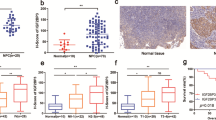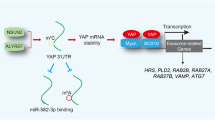Abstract
The metastasis-associated protein 1 (MTA1) is overexpressed in various human cancers and is closely connected with aggressive phenotypes; however, little is known about the transcriptional regulation of the MTA1 gene. This study identified the MTA1 gene as a target of p53-mediated transrepression. The MTA1 promoter contains two putative p53 response elements (p53REs), which were repressed by the p53-inducing drug 5-fluorouracil (5-FU). Notably, 5-FU treatment decreased MTA1 expression only in p53 wild-type cells. p53 and histone deacetylases 1/2 were recruited, and acetylation of H3K9 was decreased on the promoter region including the p53REs after 5-FU treatment. Proteomics analysis of the p53 repressor complex, which was pulled down by the MTA1 promoter, revealed that the poly(ADP-ribose) polymerase 1 (PARP-1) was part of the complex. Interestingly, p53 was poly(ADP-ribose)ylated by PARP-1, and the p53-mediated transrepression of the MTA1 gene required poly(ADP-ribose)ylation of p53. In summary, we report a novel function for poly(ADP-ribose)ylation of p53 in the gene-specific regulation of the transcriptional mode of p53 on the promoter of MTA1.
This is a preview of subscription content, access via your institution
Access options
Subscribe to this journal
Receive 50 print issues and online access
$259.00 per year
only $5.18 per issue
Buy this article
- Purchase on Springer Link
- Instant access to full article PDF
Prices may be subject to local taxes which are calculated during checkout






Similar content being viewed by others
References
Cartharius K, Frech K, Grote K, Klocke B, Haltmeier M, Klingenhoff A et al. (2005). MatInspector and beyond: promoter analysis based on transcription factor binding sites. Bioinformatics 21: 2933–2942.
Denslow SA, Wade PA . (2007). The human Mi-2/NuRD complex and gene regulation. Oncogene 26: 5433–5438.
Estève PO, Chin HG, Pradhan S . (2005). Human maintenance DNA (cytosine-5)-methyltransferase and p53 modulate expression of p53-repressed promoters. Proc Natl Acad Sci USA 102: 1000–1005.
Godar S, Ince TA, Bell GW, Feldser D, Donaher JL, Bergh J et al. (2008). Growth-inhibitory and tumor- suppressive functions of p53 depend on its repression of CD44 expression. Cell 134: 62–73.
Juan LJ, Shia WJ, Chen MH, Yang WM, Seto E, Lin YS et al. (2000). Histone deacetylases specifically down-regulate p53-dependent gene activation. J Biol Chem 275: 20436–20443.
Kai L, Wang J, Ivanovic M, Chung YT, Laskin WB, Schulze-Hoepfner F et al. (2011). Targeting prostate cancer angiogenesis through metastasis-associated protein 1 (MTA1). Prostate 71: 268–280.
Kanai M, Hanashiro K, Kim SH, Hanai S, Boulares AH, Miwa M et al. (2007). Inhibition of Crm1-p53 interaction and nuclear export of p53 by poly(ADP-ribosyl)ation. Nat Cell Biol 9: 1175–1183.
Kim MY, Zhang T, Kraus WL . (2005). Poly(ADP-ribosyl)ation by PARP-1: ‘PAR-laying’ NAD+ into a nuclear signal. Genes Dev 19: 1951–1967.
Kraus WL. (2008). Transcriptional control by PARP-1: chromatin modulation, enhancer-binding, coregulation, and insulation. Curr Opin Cell Biol 20: 294–302.
Krishnakumar R, Kraus WL. (2010). The PARP side of the nucleus: molecular actions, physiological outcomes, and clinical targets. Mol Cell 39: 8–24.
Kumari SR, Mendoza-Alvarez H, Alvarez-Gonzalez R. (1998). Functional interactions of p53 with poly(ADP-ribose) polymerase (PARP) during apoptosis following DNA damage: covalent poly(ADP-ribosyl)ation of p53 by exogenous PARP and noncovalent binding of p53 to the M(r) 85 000 proteolytic fragment. Cancer Res 58: 5075–5078.
Lewis BC, Klimstra DS, Socci ND, Xu S, Koutcher A, Varmus HE . (2005). The absence of p53 promotes metastasis in a novel somatic mouse model for hepatocellular carcinoma. Mol Cell Biol 25: 1228–1237.
Li DQ, Divijendra Natha Reddy S, Pakala SB, Wu, X, Zhang Y et al. (2009a). MTA1 coregulator regulates p53 stability and function. J Biol Chem 284: 34545–34552.
Li DQ, Ohshiro K, Reddy SD, Pakala SB, Lee MH, Zhang Y et al. (2009b). E3 ubiquitin ligase COP1 regulates the stability and functions of MTA1. Proc Natl Acad Sci USA 106: 17493–17498.
Li DQ, Pakala SB, Reddy SD, Ohshiro K, Peng SH, Lian Y et al. (2010a). Revelation of p53-independent function of MTA1 in DNA damage response via modulation of the p21 WAF1-proliferating cell nuclear antigen pathway. J Biol Chem 285: 10044–10052.
Li DQ, Ohshiro K, Khan MN, Kumar R . (2010b). Requirement of MTA1 in ATR-mediated DNA damage checkpoint function. J Biol Chem 285: 19802–19812.
Longley DB, Harkin DP, Johnston PG. (2003). 5-fluorouracil: mechanisms of action and clinical strategies. Nat Rev Cancer 3: 330–338.
Lönn P, van der Heide LP, Dahl M, Hellman U, Heldin CH, Moustakas A . (2010). PARP-1 attenuates Smad-mediated transcription. Mol Cell 40: 521–532.
Lu H, Wang X, Li T, Urvalek AM, Yu L, Li J et al. (2011). Identification of Poly (ADP-ribose) Polymerase-1 (PARP-1) as a Novel Kruppel-like Factor 8-interacting and -regulating Protein. J Biol Chem 286: 20335–20344.
Mazumdar A, Wang RA, Mishra SK, Adam L, Bagheri-Yarmand R, Mandal M et al. (2001). Transcriptional repression of oestrogen receptor by metastasis-associated protein 1 corepressor. Nat Cell Biol 3: 30–37.
Meek DW, Anderson CW . (2009). Posttranslational modification of p53: cooperative integrators of function. Cold Spring Harb Perspect Biol 1: a000950.
Mehrotra P, Riley JP, Patel R, Li F, Voss L, Goenka S . (2011). PARP-14 functions as a transcriptional switch for Stat6-dependent gene activation. J Biol Chem 286: 1767–1776.
Mendoza-Alvarez H, Alvarez-Gonzalez R . (2001). Regulation of p53 sequence-specific DNA-binding by covalent poly(ADP-ribosyl)ation. J Biol Chem 276: 36425–36430.
Moon HE, Cheon H, Chun KH, Lee SK, Kim YS, Jung BK et al. (2006). Metastasis-associated protein 1 enhances angiogenesis by stabilization of HIF-1alpha. Oncol Rep 16: 929–935.
Morton JP, Klimstra DS, Mongeau ME, Lewis BC. (2008). Trp53 deletion stimulates the formation of metastatic pancreatic tumors. Am J Pathol 172: 1081–1087.
Na TY, Shin YK, Roh KJ, Kang SA, Hong I, Oh SJ et al. (2009). Liver X receptor mediates hepatitis B virus X protein-induced lipogenesis in hepatitis B virus-associated hepatocellular carcinoma. Hepatology 49: 1122–1131.
O'Shaughnessy J, Schwartzberg LS, Danso MA, Rugo HS, Miller K, Yardley DA et al. (2011). A randomized phase III study of iniparib (BSI-201) in combination with gemcitabine/carboplatin (G/C) in metastatic triple-negative breast cancer (TNBC). J Clin Oncol 29 (suppl) (abstract 1007).
Petty RD, Samuel LM, Murray GI, MacDonald G, O'Kelly T, Loudon M et al. (2009). APRIL is a novel clinical chemo-resistance biomarker in colorectal adenocarcinoma identified by gene expression profiling. BMC Cancer 9: 434.
Porta C, Hadj-Slimane R, Nejmeddine M, Pampin M, Tovey MG, Espert L et al. (2005). Interferons alpha and gamma induce p53-dependent and p53-independent apoptosis, respectively. Oncogene 24: 605–615.
Qian H, Lu N, Xue L, Liang X, Zhang X, Fu M et al. (2005). Reduced MTA1 expression by RNAi inhibits in vitro invasion and migration of esophageal squamous cell carcinoma cell line. Clin Exp Metastasis 22: 653–662.
Riley T, Sontag E, Chen P, Levine A. (2008). Transcriptional control of human p53-regulated genes. Nat Rev Mol Cell Biol 9: 402–412.
Simbulan-Rosenthal CM, Rosenthal DS, Luo R, Smulson ME. (1999). Poly(ADP-ribosyl)ation of p53 during apoptosis in human osteosarcoma cells. Cancer Res 59: 2190–2194.
Sung YH, Kim HJ, Devkota S, Roh J, Lee J, Rhee K et al. (2010). Pierce1, a novel p53 target gene contributing to the ultraviolet-induced DNA damage response. Cancer Res 70: 10454–10463.
Toh Y, Nicolson GL. (2009). The role of the MTA family and their encoded proteins in human cancers: molecular functions and clinical implications. Clin Exp Metastasis 26: 215–227.
Vousden KH, Lane DP. . (2007). p53 in health and disease. Nat Rev Mol Cell Biol 8: 275–283.
Wang B, Xiao Z, Ren EC. (2009a). Redefining the p53 response element. Proc Natl Acad Sci USA 106: 14373–14378.
Wang B, Xiao Z, Ko HL, Ren EC. (2010). The p53 response element and transcriptional repression. Cell Cycle 9: 870–879.
Wang SP, Wang WL, Chang YL, Wu CT, Chao YC, Kao SH et al. (2009b). p53 controls cancer cell invasion by inducing the MDM2-mediated degradation of Slug. Nat Cell Biol 11: 694–704.
Wesierska-Gadek J, Schmid G, Cerni C. (1996). ADP-ribosylation of wild-type p53 in vitro: binding of p53 protein to specific p53 consensus sequence prevents its modification. Biochem Biophys Res Commun 224: 96–102.
Yap TA, Sandhu SK, Carden CP, de Bono JS. (2011). Poly(ADP-ribose) polymerase (PARP) inhibitors: Exploiting a synthetic lethal strategy in the clinic. CA Cancer J Clin 61: 31–49.
Yoo YG, Kong G, Lee MO. (2006). Metastasis-associated protein 1 enhances stability of hypoxia-inducible factor-1alpha protein by recruiting histone deacetylase 1. EMBO J 25: 1231–1241.
Yoo YG, Na TY, Seo HW, Seong JK, Park CK, Shin YK et al. (2008). Hepatitis B virus X protein induces the expression of MTA1 and HDAC1, which enhances hypoxia signaling in hepatocellular carcinoma cells. Oncogene 27: 3405–3413.
Zampieri M, Passananti C, Calabrese R, Perilli M, Corbi N, De Cave F et al. (2009). Parp1 localizes within the Dnmt1 promoter and protects its unmethylated state by its enzymatic activity. PLoS One 4: e4717.
Zardo G, Caiafa P. (1998). The unmethylated state of CpG islands in mouse fibroblasts depends on the poly(ADP-ribosyl)ation process. J Biol Chem 273: 16517–165120.
Acknowledgements
This work was supported by grants from the NRF (2009-0080757), and the SRC/ERC (R11-2007-107-01001-0).
Author information
Authors and Affiliations
Corresponding author
Ethics declarations
Competing interests
The authors declare no conflict of interest.
Additional information
Supplementary Information accompanies the paper on the Oncogene website
Rights and permissions
About this article
Cite this article
Lee, MH., Na, H., Kim, EJ. et al. Poly(ADP-ribosyl)ation of p53 induces gene-specific transcriptional repression of MTA1. Oncogene 31, 5099–5107 (2012). https://doi.org/10.1038/onc.2012.2
Received:
Revised:
Accepted:
Published:
Issue Date:
DOI: https://doi.org/10.1038/onc.2012.2
Keywords
This article is cited by
-
Impact of NAD+ metabolism on ovarian aging
Immunity & Ageing (2023)
-
Metastasis-associated protein 1: A potential driver and regulator of the hallmarks of cancer
Journal of Biosciences (2022)
-
High speed of fork progression induces DNA replication stress and genomic instability
Nature (2018)
-
Superfast DNA replication causes damage in cancer cells
Nature (2018)
-
LSD1 demethylates HIF1α to inhibit hydroxylation and ubiquitin-mediated degradation in tumor angiogenesis
Oncogene (2017)



